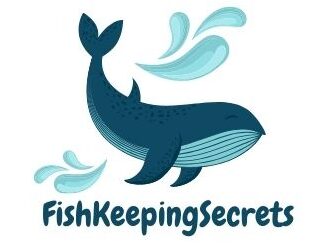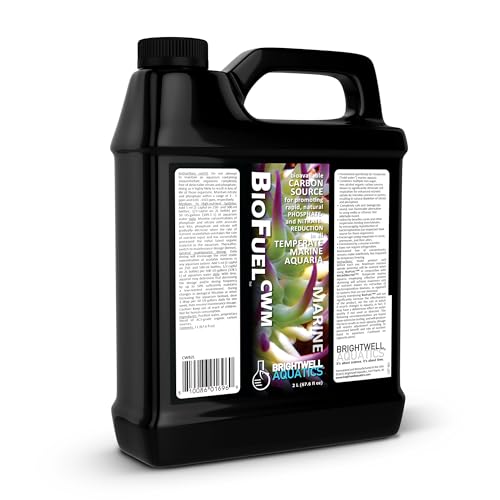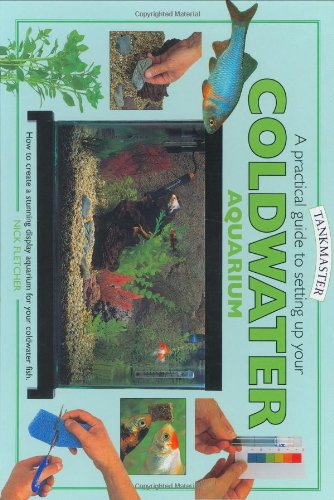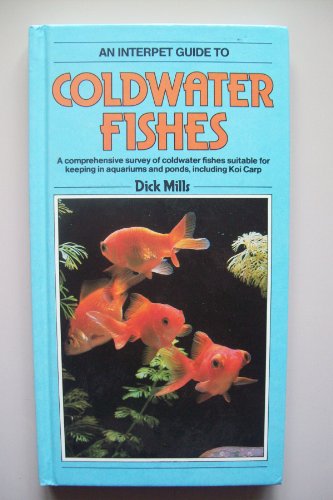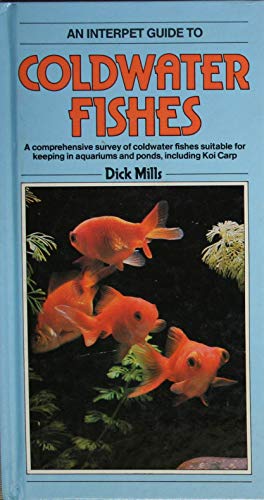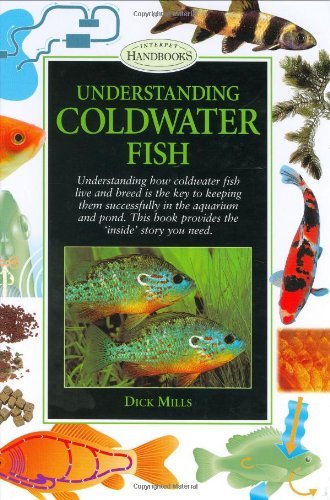10 Best Coldwater Aquarium Fishes [2025]
This post contains affiliate links. As an Amazon Associate, we earn from qualifying purchases.
Finding the best coldwater aquarium fishes can be a daunting task, especially with the myriad of options available, each with unique care requirements and compatibility issues. To simplify your search, we have meticulously shortlisted the top 10 products based on factors such as popularity, ease of care, and community feedback. Our curated list not only highlights the finest choices but also saves you time and hassle, ensuring you can confidently select the ideal fish for your aquarium setup.
Top 10 Coldwater Aquarium Fishes In The Market
Coldwater Aquarium Fishes Review
- Wingerter, Kenneth (Author)
- English (Publication Language)
- 112 Pages - 09/01/2016 (Publication Date) - CreateSpace Independent Publishing Platform (Publisher)
- Used Book in Good Condition
- Hardcover Book
- Fletcher, Nick (Author)
- English (Publication Language)
- 77 Pages - 11/21/2025 (Publication Date) - Interpet Ltd (Publisher)
- Used Book in Good Condition
- Hardcover Book
- Dick Mills (Author)
- English (Publication Language)
- 116 Pages - 05/11/2004 (Publication Date) - Interpet Publishing (Publisher)
- Aquaria, Flo (Author)
- English (Publication Language)
- 218 Pages - 10/10/2021 (Publication Date) - Independently published (Publisher)
- MULTI-CARBON FORMULA FOR NUTRIENT CONTROL Blended organic carbon sources fuel microbial activity and reduce nitrate and phosphate in coldwater marine aquariums.
- BOOSTS NATURAL FILTRATION PERFORMANCE Enhances the growth of beneficial biomass that supports coral and invertebrate feeding while reducing dissolved waste.
- REPLACES UNSAFE DIY METHODS Provides a clean, stable alternative to vodka or ethanol dosing without risk of unbalanced nutrient shifts.
- IMPROVES POLYP EXTENSION AND COLORATION Supports coral and anemone health by encouraging bacterioplankton production, enhancing food availability and color vibrancy.
- AMERICAN-MADE EXCELLENCE – Brightwell Aquatics is an industry-leading brand committed to providing innovative and scientifically backed aquatic care products. Made in the USA, we consistently deliver advanced superior quality solutions to elevate the vibrancy and health of your aquarium.
- all round book covering all aspects of setting up a aquarium
- Hardcover Book
- Fletcher, Nick (Author)
- English (Publication Language)
- 77 Pages - 02/01/2002 (Publication Date) - Interpet Ltd (Publisher)
- Hardcover Book
- Mills, Dick (Author)
- English (Publication Language)
- 120 Pages - 01/16/1992 (Publication Date) - Salamander Books (Publisher)
- Contains one (1) API TAP WATER CONDITIONER Aquarium Water Conditioner 16-Ounce Bottle
- Neutralizes chlorine, chloramines and other chemicals to make tap water safe for fish
- Prevents tap water chemicals from causing gill destruction, tissue irritation and fish death
- Super strength, high concentration formula
- Use when adding or changing water and when adding new fish to freshwater and saltwater aquariums
- Used Book in Good Condition
- Hardcover Book
- Mills, Dick (Author)
- English (Publication Language)
- 144 Pages - 09/01/2000 (Publication Date) - Interpet Ltd (Publisher)
Our Review Process
To ensure you get reliable product recommendations, we follow a detailed review methodology that includes:
- Market Research: Scanning best-selling and trending products in this category.
- User Feedback: Reviewing customer reviews, star ratings, and complaints.
- Hands-On Testing: Trying select products ourselves when feasible.
- Feature Comparison: Evaluating specs, durability, pricing, and safety.
- Expert Opinions: Consulting with niche experts or credible reviewers.
We independently select the top 10 options based on value, quality, and usability. To learn more, visit our detailed review process.
Key Considerations Before Buying Coldwater Aquarium Fishes
1. Tank Size
The size of your aquarium is one of the most important factors to consider. Coldwater fish require ample space to swim and thrive. A larger tank can also help maintain stable water parameters, which is crucial for the health of the fish. Consider the adult size of the fish species you are interested in, as overcrowding can lead to stress and health issues.
2. Water Parameters
Coldwater fish have specific requirements for water temperature, pH, hardness, and ammonia/nitrite/nitrate levels. Before purchasing any fish, research the ideal water conditions for the species you wish to keep. Make sure you have the necessary equipment, such as heaters, filters, and test kits, to maintain these conditions in your aquarium.
3. Compatible Species
When selecting coldwater fish, compatibility is crucial. Not all species can coexist peacefully in the same tank. Research which species are known to be compatible and consider their temperaments, dietary needs, and social behaviors. Avoid mixing aggressive species with more docile ones to prevent stress and potential harm.
4. Diet and Feeding
Understanding the dietary needs of your chosen species is essential for their long-term health. Different coldwater fish have varying diets, from herbivorous to carnivorous. Ensure you can provide appropriate food options, whether it be flakes, pellets, or live food. Regular feeding schedules and portion control also play a role in maintaining water quality.
5. Tank Mates
In addition to species compatibility, consider the overall community of your aquarium. Think about the size and behavior of potential tank mates. Some fish are more territorial or aggressive, which can lead to conflicts. Research community tanks and establish a harmonious environment that caters to all inhabitants.
6. Filtration and Aeration
Coldwater fish require good water quality to thrive, which makes filtration and aeration vital components of your aquarium setup. Invest in a high-quality filter that can handle the volume of your tank and ensure adequate aeration to keep oxygen levels optimal. Regular maintenance of these systems is crucial for the health of your fish.
7. Maintenance and Care
Owning an aquarium requires regular maintenance, including water changes, cleaning, and monitoring water parameters. Be prepared to commit time and effort to keep your tank in optimal condition. Research the specific care needs for your coldwater fish to ensure they live long, healthy lives.
8. Source of Fish
Consider where you will purchase your coldwater fish. Local fish stores, online retailers, and breeding farms each have their pros and cons. Look for reputable sources that provide healthy fish and proper care information. Avoid purchasing from questionable sources to reduce the risk of introducing diseases to your aquarium.
9. Budget
Finally, consider your budget. The initial cost of the aquarium setup, including tank, equipment, and fish, can add up quickly. Additionally, factor in ongoing costs for food, water treatment, and maintenance supplies. Make sure you have a clear financial plan before diving into coldwater fishkeeping.
FAQs
What are coldwater aquarium fishes?
Coldwater aquarium fishes are species that thrive in lower temperature environments, typically between 60°F to 75°F (15°C to 24°C). They do not require heaters in their tanks, making them ideal for beginners or hobbyists looking for low-maintenance options.
What are some popular coldwater fish species?
Some popular coldwater fish species include goldfish, koi, white cloud mountain minnows, danios, and various types of barbs, such as cherry barbs and rainbow barbs. Other options include orandas, shubunkins, and comet goldfish.
Can I keep coldwater fish with other fish species?
Yes, coldwater fish can sometimes be kept with other species, but it’s essential to choose compatible tank mates. Species that thrive in similar temperature ranges, such as some types of tetras or guppies, can be considered, but careful monitoring of water conditions and behaviors is necessary.
What size aquarium is needed for coldwater fish?
The size of the aquarium depends on the species and number of fish you plan to keep. A minimum of 20 gallons is generally recommended for coldwater fish like goldfish, as they can grow quite large and produce a significant amount of waste. Always research individual species requirements for the best results.
How do I maintain water quality for coldwater fish?
Maintaining water quality involves regular water changes, typically 10-20% weekly, testing water parameters like pH, ammonia, nitrite, and nitrate levels, and ensuring proper filtration. Using a quality water conditioner and keeping the tank clean will also help maintain a healthy environment for coldwater fish.
What should I feed coldwater aquarium fish?
Coldwater fish can be fed a variety of diets, including high-quality flakes or pellets designed for coldwater species, live or frozen foods such as daphnia or brine shrimp, and occasional treats like blanched vegetables. It’s important to provide a balanced diet and avoid overfeeding.
Do coldwater fish require a heater?
Generally, coldwater fish do not require a heater, as they thrive in cooler temperatures. However, if you live in a particularly warm climate or your home temperature fluctuates significantly, you may need to monitor the water temperature closely and consider using a heater with a thermostat set to maintain cooler conditions if necessary.
How can I prevent diseases in coldwater fish?
Preventing diseases involves maintaining good water quality, avoiding overcrowding, providing a balanced diet, and observing your fish for any signs of stress or illness. Quarantining new fish before introducing them to the main tank can also help prevent the introduction of diseases.
How often should I clean the aquarium?
Regular maintenance is crucial for the health of your coldwater fish. A partial water change of 10-20% should be done weekly, and the substrate and decorations should be cleaned as needed to remove waste and algae. A thorough cleaning of the tank and equipment can be done every few months, but be careful not to disrupt the established beneficial bacteria.
What are the common problems with coldwater fish keeping?
Common problems include poor water quality, overpopulation, inappropriate tank mates, and insufficient diet. Additionally, coldwater fish can be susceptible to diseases like ich and fin rot, especially if stressed or conditions in the tank are not optimal.
The Bottom Line
In conclusion, selecting the right coldwater aquarium fish can greatly enhance your aquatic experience, turning your tank into a vibrant and lively ecosystem. The ten species we’ve highlighted in this article were carefully chosen based on their compatibility, hardiness, and aesthetic appeal. We considered factors such as ease of care, ideal tank conditions, and the potential for companionship among different species. Each fish on our list represents a unique set of characteristics that can cater to both novice and experienced aquarists alike.
By following our curated list, you can confidently create a thriving coldwater aquarium that is not only visually stunning but also sustainable and harmonious. Whether you’re looking to add a splash of color to your home or embark on a new hobby, these selections provide a solid foundation for a successful coldwater aquarium. With the right knowledge and proper care, you can enjoy the beauty and serenity that these fish bring, while also gaining valuable insights into aquatic ecosystems and their maintenance.
